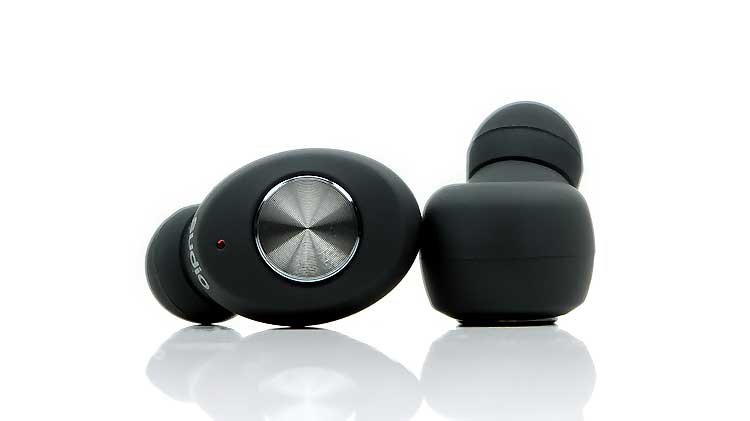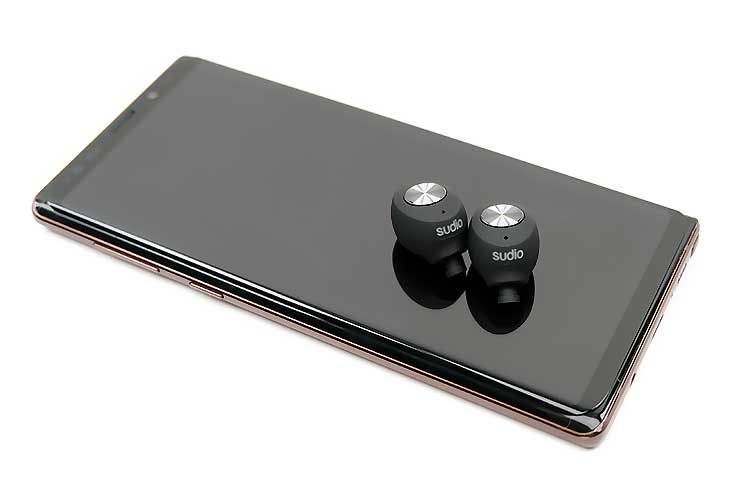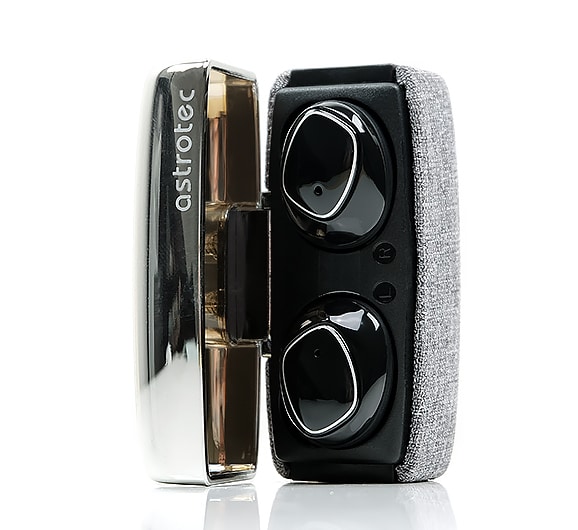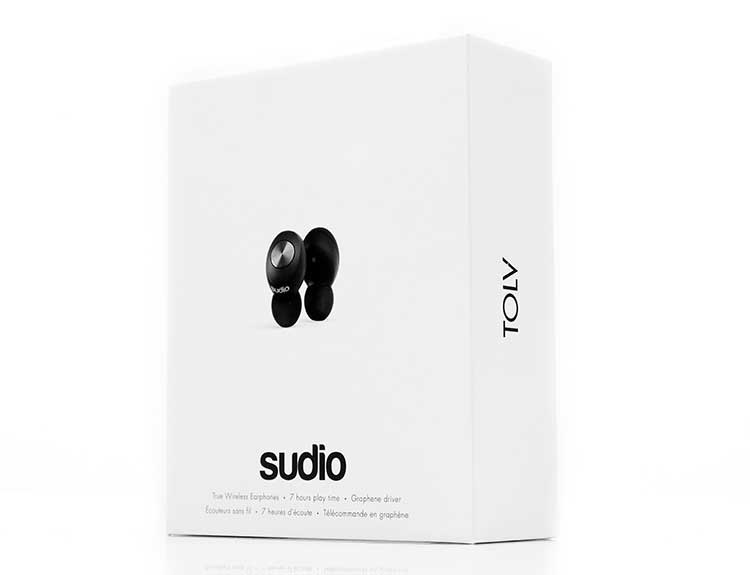Sound Impressions
Summary
Like the MPOW M50 and Astrotec S80, the TOLV has a definite V-shaped tuning but possibly more exaggerated than either of these two.
The key differences are a fairly dominant low-end with more sub-bass quantity, a dipped midrange, and some upper treble sparkle. The bass/treble contrast is thus far greater on the TOLV compared to either of these V-Shaped competitors which have a bit more upper treble fade and a slightly softer overtone.
As a result, you get plenty of power, plenty of depth but there is a slight lack of bass definition and a slow long dynamic driver decay. The resulting output is heavy but a little soft and bloomed. The tuning then cuts quite quickly into the lower-mids so mids up to around 1-2k are fairly dipped and lacking in body and presence.
Beyond that, you get an elevated upper mids with female vocals doing better than male vocals, especially when the bass gets called upon. Percussion has plenty of presence but they lack a little body for me. At times, female vocals can also seem a little sibilant with a slight predominance of odd-harmonic overtones. I would still rate Jade Audio’s EW1’s upper mids as more metallic sounding though.
Treble is not so elevated until around 7k then you get a bit of a peak up to around 8-9k. You really need that elevation to prevent the TOLV from becoming dark and veiled sounding, especially on the mids’ performance. In turn, that sort of robs the percussion and higher-pitched vocal of a bit of wetness and body that I mentioned earlier.
Staging
However, the TOLV can sound quite tall and deep with good headroom and plenty of ‘exciting ‘bass/treble’ contrast that plays out well in a casual manner for EDM. Percussion sounds energetic, kick-drums are to the fore and when things calm down female vocals carry an ethereal and clear quality to their timbre.
The cost, however, is instrumental separation with a fairly narrow staging width and a center focused imaging capability. If you need that grab the TEVI which sounds much more open. Otherwise, the TOLV is tailor-made for huge thumping House and non-vocal synthwave EDM genre.
Wireless Performance
Pairing
The TOLV is one of the easiest pairings I have had with a TWS system to date. When reading the instructions I thought the independent pairing process might be as tricky as the HELM TW5.0 experience but it proved not to be the case.
Simply take both drivers out of the box, turn on the Bluetooth from your source and look for “Sudio Tolv” in your devices detected list and then hit pair. You will hear “device connected’ in the right ear when paired but once you play music it will all be in stereo or from both drivers. If at any time you do not see the listed TWS simply put them back in the cradle and repeat the process.
(Pairing was done on 3 devices – Windows 10 PC Bluetooth, Samsung Note 9, and Huawei P20)
Stability & Range
Left/right stability seems ok to me testing 4 devices. This included our two smartphones, the P30 and Note 9 as well as the Lotoo PAW Gold Touch and the new FiiO M15. Anytime I got drop out both channels dropped out the same time so that is more source signal disruption than left-right instability.
Distance is variable in performance with the TOLV. I would place the range capacity of the TOLV int he second tier along with the MPOW M50. Just ahead of Jade Audio’s EW1, KZ T1 and Airdots but behind HELM’s TW5.0 and the Astrotec S80. In our tests with the two smartphones, we also found it slightly more stable than the Lypertek TEVI with one wall and around 10 meters.
Like most other TWS, we found the range to decrease with DAPs such as the new FiiO M15 and it barely worked at all on the Lotoo PAW Gold Touch. This is a problem DAP for BT TWS connections so unlikely we will use it again for testing.
Latency
With a 16BIT/48k audio track layer on a 1341kbps video file using VLC on Windows 10, you can get away with a zero second delay but only just. If you are a stickler for absolute precision I found the TOLV to be similar again to the MPOW M5 at around 0.2 seconds hastened but it is a marginal decision and might depend on the data rate or specific source/player you use.
Select Comparisons
Astrotec S80
$89.99
Technical
The Astrotec S80 is priced a little lower than the Sudio TOLV at $89.99 but also does not offer aptX decoding. Like the TOLV Astrotec has focused on driver quality with the use of a single beryllium driver and SBC/AAC decoding capability. They also both use Bluetooth 5.0.
The feature range beyond that is a little more comprehensive than the TOLV including cVc 8.0 noise suppression, voice assistant, IPX5 waterproofing, USB-C charging, and touch controls. The styling or design is a little less trendy in its finishing with a plainer matter plastic and glossy faceplate. The form factor is much bigger but like the TOLV it has a fairly stubby nozzle so tips are just as important with the S80.
The cradle is quite different in aesthetics and also draws from a Nordic-inspired cloth finish. The chrome on top does give the S80 cradle some distinctive appeal. USB-C charging on the rear is an advantage over the TOLV micro-USB option.
TOLV has an edge in terms of battery life with 6-7 hours compared to 5-6 for the drivers and 35 hours compared to 20-25 hours for the cradle. despite having USB-C the S80 will not fast charge so both are about the same time to go from 0 to 100%.
Performance
The S80 has a better range and stability over that enhanced range. I found I could push one more wall between the S80 at 10m compared to the TOLV which cut out at the same distance. The S80 and HELM TW5.0 are the two best performers for the range I have tested thus far.
Pairing on both is pretty easy but the SOLV is definitely more ‘pick and go’ as you only see the one entry, “Sudio Solv” on your BT scanning list and no left or right which you get on the S80. Much simpler. The S*0 has a tiny advantage on latency by about 0.1s hastened on VLC.
Tuning
(Comparison was done with FiiO Vocal single bore silicone tips which create a more effective seal on the SOLV than the stock tips)
As with the TEVI, the SOLV amp has more power or the driver is more efficient. Either way, you will find yourself dropping the volume a tiny bit on the SOLV to match the S80.
Both of these are V-shaped but the SOLV is more exaggerated on the low-end with a bit more sub-bass quantity and treble contrast. It carries far more power and depth as a result but on the flip side, the lower-mids are not as dominant of full-bodied sounding as the S80. The S80 sounds the warmer of the two through the mid-bass and lower-mids.
Upper mids on both are very good actually with the right tracks, usually modern R’n’B and EDM. The SOLV shows a bit of elevation around female vocals and they do sound clean and clear when the low-end is not called upon. The S80 is marginally less forward, even though I still would term them as having more focused upper mids.
The key difference beyond 2-3k on both is more in the timbre. The SOLV upper treble delivers a cleaner contrast than the slight upper treble fade of the S80. The S80 has less of a lower treble dip also so percussion has better presence but a slightly wetter tone and a bit more body. The SOLV has a bit more bite and perceived height or clarity but it is an ethereal sound with less body, especially for percussion.
MPOW M5
$49.99
Technical
The cheapest of the single driver TWS we are comparing at just $49.99 but it does come packed with some good features. This includes BT5.0, cVc 8.0 noise suppression, IPX7, and aptX decoding. The TOLV does have BT5 but has no weather resistance and only does SBC and AAC max for decoding.
The M5 is capable of voice assistant control but its physical button system is not as comfortable to use as the smoother action and positioning of the TOLV system. The M5 design is also a bit bulkier and not as nicely finished. However, the M5 nozzle is longer so the seal is better with the stock tips. The TOLV needs better tips to combat the effects of a shorter nozzle.
The same for the case. The M5 finish is nice but not as ‘cute’ as the rubbery finish of the Sudio TOLV and much bigger also. Big does not mean more capacity either as both have a similar capacity. The M5 is 30-40 hours and the TOLV smaller cradle is 35 hours. The TOLV drivers also have about a 1-hour advantage over the 5-6 hour life cycle of the M5. Both are micro-USB connected.
Performance
The performance of these two are very closely matched in terms of latency, pairing, and stability over a range. In fact, almost identical. I can get both to the same 10-15m distance with one wall and both stop almost the same spot once I slip behind a second wall at around 10m. The latency is locked in at around 0.2s hastened on VLC with the same movie track and bit/sample rates and the pairing of both is very easy.
Tuning
(Comparison was done with FiiO Vocal single bore silicone tips which create a more effective seal on the SOLV than the stock tips)
Both of these are v-shaped TWS aiming for a similar consumer target market. However, they do have some differences in how that V-shaped is tweaked. The SOLV has a bit more bloom in its bass with the M5 marginally tighter or with a bit more definition.
The M5 mids also are not quite as dipped so they convey a bit more detail than the SOLV mids which can often sound overwhelmed by the low-end by comparison. The M5 upper mids and treble are also a little smoother and more open sounding.
The SOLV tends to focus more on an elevated upper treble for sparkle so timbre is cleaner and crisper. This is especially on percussion but again, just a little less body and a bit more sibilance. When things are quiet you do get a perception of more height also from the TOLV but the general overtone can sound sharper than the M5.
Lypertek TEVI
$129
Technical
At the same price, the TEVI has a lot to offer. Both have BT5.0 and left-right connectivity. However, the TEVI goes further with its own app, aptX decoding, IPX7, TrueWireless Stereo Plus, and cVc 8.0 technology.
Further to that, their cradle is USB-C terminated with quick-charge. Now the numbers state a bit longer than the TOLV at just over 2 hours compared to 1.5 but that’s due to the mammoth 70-hour cradle capacity. That is best in class thus far in our TWS reviews. That is double the TOLV’s cradle capacity of 35 hours.
The design on the TEVI is good with some shared cloth finishing from the Astrotec S80 and a leather lanyard but it is fashioned out of the cheaper M5 cradle. I do prefer the more pocketable size of the TOLV, the rubbery finish.
Drivers on the TEVI are also very impressive at around 8 hours battery life compared to 6-7 on the TOLV. They are also a bit more stylish with their rubbery finish. However, the form factor on the TEVI is the same as the M5 with its longer nozzle so it does seal quite well with the stock tips.
Performance
Stability over range on the SOLV is better than the TEVI. That is the TEVI’s weak spot for me. I did get a bit more signal choppiness over the 10m range with the TOLVI compared to the smoother SOLV performance. The left and right stability on both TWS was fine, no short or medium issues and when drop out occurred it happened on both drivers at the same time.
Latency on the TEVI is slightly better than the SOLV at around 0.1s hastened max using VLC on Windows 10 compared to around 0.2s hastened on the SOLV. There is a bit of a grey are on both between 0.1 and 0.2 on both but overall the TEVI just felt the tighter on audio sync.
Tuning
(Comparison was done with FiiO Vocal single bore silicone tips which create a more effective seal on the SOLV than the stock tips)
The first thing to do when comparing these two is to adjust the volume as the SOLV TWS seems easier to drive or the TEVI has a weaker or lower gain amp. I would say about 1-2 steps lower on smartphones would be about right for rough volume matching.
The SOLV is more V-shaped compared to the TEVI. The TEVI has a reduce sub-bass weight and slightly less upper treble presence. Mid-bass is warmer and slightly punchier on the TEVI with the SOLV mids sounding thinner and more recessed in comparison to the extreme ends of the spectrum.
The TEVI also has a bit more instrumental separation in the mids and sounds the more expansive of the two for staging width. The SOLV is much the deeper of the two with its heavy sub-bass bias so its quite powerful sounding. The flipside, its mids are a bit veiled with less separation so not the best performers for traditional rock or mid-focused tracks.
Treble is mixed between the two. The SOLV has more upper treble and I presume to create a more exciting contrast with the powerful low-end and prevent it from sounding dark. The TEVI has a bit more consistency but a slight fade in the upper treble to smooth it out.
The sound is thus wetter with slightly less sparkle compared to the SOLV. You are going to hear that a lot with house dance tambourine mix layers around 4-5k or higher sounding cleaner on the SOLV but leaner than the TEVI timbre.
Our Verdict
There is no doubting the TOLV is targeted to the casual listener, particularly with a preference for EDM and modern pop. I cannot see audiophiles going for this over the balanced Lypertek TEVI. However, this is one of the more stylish looking TWS out there with top-notch design principles, a small form factor, and modern packaging.
It has that “Apple” appeal that I know many tend to go for but more importantly, it is dead easy to set up and pair with good stability over distance. The basics can often be overlooked and frustration can lead to these things being binned all too quickly.
Change those tips though and you will get the full spectrum of its capabilities. The stock tips are too porous for me and you lose a lot of dynamic range as well as needed power. You may as well get the full bass “fun” experience with the TOLV if you are buying it for that V-shaped contrasty experience.
TOLV Specifications
- COMPATIBILITY Android, iOS
- PLAYTIME Up to 35 h total
- SWEAT RESISTANT For daily use
- BUILT-IN MICROPHONE Yes
- RANGE 15 m
- BLUETOOTH VERSION 5.0
- WARRANTY 1 year
- VOICE ASSISTED (SIRI AND GOOGLE ASSISTANT) Yes
- CODEC SBC, AAC










